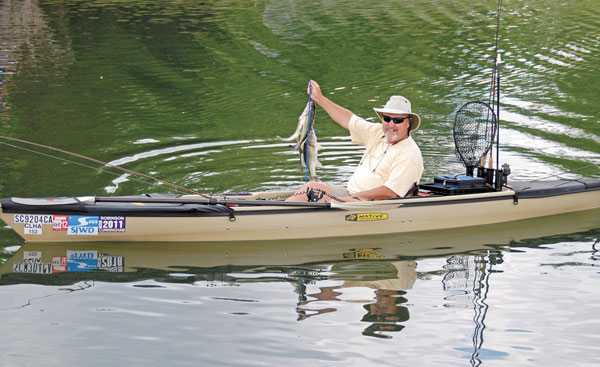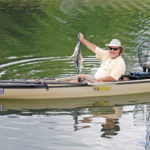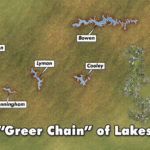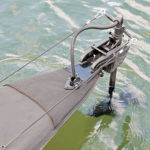
While most anglers merely hope to catch fish on an outing on the water, Bob Beals of Inman expects to catch fish on every foray he makes to one of the Upstate’s water-district lakes. Sometimes referred to as the “Greer Chain of Lakes,” these small reservoirs offer good fishing in close proximity to the metropolitan Greenville/Spartanburg area.
The Greer Commission of Public Works, Spartanburg Water District, and Startex, Jackson, Wellford, Duncan Water District each own and operate multiple small reservoirs used to store drinking water. By county, there’s Robinson and Cunningham in Greenville County, and Lyman, Cooley, Bowen, and Blalock in Spartanburg County. Each district requires an annual permit fee to access the lakes, though some also offer daily passes.
Owing to their small stature — Cunningham is the smallest at 250 acres, and Bowen is the largest at 1,534 — most of these lakes have boat and motor size restrictions, making them prime destinations for paddlers who don’t want to be worried about being run over by jet skis or powerboats.
Built for water retention, the majority of these lakes share similar topography — amoebae-shaped bowls lacking substantial tributaries. The water is typically clear, and roughly half the shorelines are developed.
Lake Bowen, northeast of Inman, has approximately 55 miles of shoreline, much of which is developed. This means there are a lot of boat docks, brushpiles, and isolated laydowns in the lake.
In 2007, Spartanburg Water System completed a project to raise the level of Lake Blalock, northeast of Spartanburg, from 700 to 710 feet above sea level. This required raising the Blalock dam by 10 feet and clearing the surrounding shoreline. Blalock spans approximately 1,200 acres.
Lyman, a 500-acre impoundment of the Middle Tyger River, is the older of the two publicly accessible SJWD reservoirs and contains much old development shoreline cover in the form of docks and piers.
Lake Cooley is the 300-acre sister impoundment of Lyman characterized as a “bowl shaped” reservoir with no well-defined river channel.
Lake Robinson, at 840 acres, is the larger and newer of the Greer CPW facilities. Wide and deep for a small impoundment, much of its shoreline is gently sloped — similar to Lake Cooley. While the shoreline is widely developed, there are many pockets and coves, especially at the backs of several of the small tributaries that feed into the lake.
Lake Cunningham, recognized by many old timers as “Greer Lake,” is riverine in nature and winds its way out of Cunningham swamp to the dam near the CPW water plant. Many of Cunningham’s docks and shoreline structure are older and bordered by broadleaf aquatic vegetation, especially above the SC 101 bridge in Cunningham swamp.
In varying stages, each of these lakes holds healthy largemouth bass, black crappie and bream populations. October means cooling water temperatures, which is why Beals can make his great expectation of catching fish on virtually every trip to one of these lakes.
“I primarily work the shorelines with a fly rod; I love to fish topwater for both bass and bream,” said Beals who fishes from a 14.5 Native Watercraft Ultimate kayak. “A medium-sized, bright-colored popping bug is my best producer. This time of year, the bite is almost instant when the bug hits the water.”
Beale prefers to start early in the morning and fish to mid-day. As the morning wears on, Beals moves his presentation to deeper water, using a spinning rod to drop-shot soft plastics.
“I look for drop-offs that provide deep water next to the shoreline,” he said. “The steeper the better: 10 to 12 feet of water 20 feet off the bank is ideal.”
It’s difficult to run and gun in a kayak, but Beals’ yak comes equipped to “run” a little better than most due to the installation of an electric trolling motor. When he has thoroughly worked an area, he’ll toss out a shallow-running crankbait behind him and troll to the next spot, often picking up a cruising bass or two on the way.
“Trolling from point to point is another great way to make use of the kayak for fishing,” he said. “My go-to trolling bait is a small 5- to 7-foot diver in natural color that I can troll anywhere from two to four mph with the electric motor.”
Each of the lakes provide access via paved ramps and boat landings. For more information on permit fees and public access, contact the Greer CPW at www.greercpw.com, SJWD Water District at www.sjwd.com, and Spartanburg Water System at www.spartanburgwater.org.





Be the first to comment